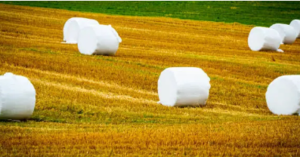Often, producers who quote a higher ‘weight’ per metre (g/m) of the net are restricted by the extrusion or manufacturing process and are unable to achieve the same strength. It may result in the net performing below standard or not working at all in your baler.
 Research has shown that wrapping with a net reduces harvest, handling, and storage losses compared to twine. Likewise, net wrap saves time with only two to four turns required versus 20 for twine.
Research has shown that wrapping with a net reduces harvest, handling, and storage losses compared to twine. Likewise, net wrap saves time with only two to four turns required versus 20 for twine.
- Less Hay Loss
Many producers use net wrap because it binds hay tighter, reducing sag and making for a denser bale. It helps hay keep its shape better during storage, reduces nutrient loss and increases hay value when sold. It also helps bales shed water, reducing spoilage and lowering storage costs.
Bales wrapped with twine lose more dry matter than net-wrapped hay during harvest and handling. Net wrap, however, holds hay more tightly and sheds moisture, minimizing harvest losses. Research out of Kentucky shows net wrap significantly reduces storage losses, too.
- Less Storage Loss
Bales wrapped in net wrap tend to lose less hay during transport and storage compared to bales bound with twine. It saves the farmer money on repurchased hay and time.
The netting adds strength to round bales and helps them stay together. It reduces the risk of them falling apart, which can be especially dangerous for the driver during transportation. The netting also makes the bales more difficult for pests to reach, such as mice and insects.
Research from Shinners documented less dry matter loss on net-wrapped tall fescue round bales than on twine-tied bales when stored outdoors. In addition, a net-wrapped bale sheds water more quickly than twine-tied bales and holds its shape better during handling.
- Less Waste
A large percentage of ranchers don’t remove net wrap prior to feeding as recommended by ag extension agents and vets because of time, labour and cost. It can lead to internal net wrap accumulation in livestock, which can cause health problems and death.
In addition to minimizing bale loss and waste, the use of net wrap also contributes to better forage quality by keeping it protected from weather elements, pests and mechanical damage during handling and transporting. In turn, this leads to a more consistent and nutritious feed supply for livestock.
The latest generation of net wrap is made with a lighter material that can be used on smaller-diameter round bales. Lighter material requires less plastic per square foot to produce, which results in a significantly lower environmental footprint. The new material also enables producers to utilize their current baling equipment with higher efficiency and performance. That is especially true for reversible net wrap, which allows the same process to be completed in half the time with less effort. It is made possible by a lighter plastic material that can be produced with a greater level of elasticity compared to standard net wrap.
- Faster Bale Wrapping
The use of net wrap for round bales is an effective way to minimize hay loss and save time. The baling process is faster because you need to make only two and a half turns to wrap a round bale with a net compared to 20 with sisal or plastic twine. It allows you to make more bales per hour, reducing machinery time, labour, and fuel costs.
According to research by the University of Wisconsin agricultural engineer Kevin Shinners, using net wrap reduces the amount of hay loss in the field by 30 to 35 percent. It is due to the fact that the wrappings keep rain, melting snow and ground moisture from entering the bale chamber.